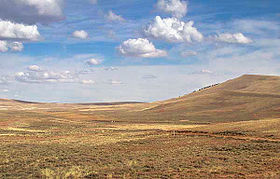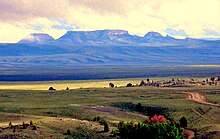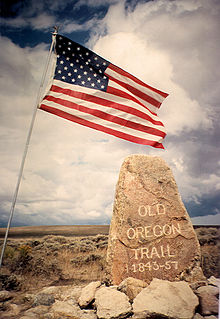South Pass (Wyoming)
| South Pass | |
|---|---|
 Historic South Pass, seen from the east looking westward towardsPacific Springs | |
| Elevation | 7,412 ft (2,259 m) |
| Traversed by | Oregon Trail,California Trail,andMormon Trail,Wyoming Highway 28 |
| Location | Fremont County,Wyoming United States |
| Range | Wind River RangeandAntelope Hills (Radium Springs, Wyoming) |
| Coordinates | 42°22′12″N108°54′49″W/ 42.37000°N 108.91361°W |
| Topo map | USGSPacific Springs |
South Pass | |
 Map of southwestern Wyoming showing location of South Pass at the headwaters of theSweetwater River | |
| Nearest city | South Pass City, Wyoming |
| NRHP referenceNo. | 66000754 |
| Significant dates | |
| Added to NRHP | October 15, 1966[1] |
| Designated NHL | January 20, 1961[2] |
South Pass(elevation 7,412 ft (2,259 m) and 7,550 ft (2,300 m)) is a route across theContinental Divide,in theRocky Mountainsin southwesternWyoming.It lies in a broad high region, 35 miles (56 km) wide, between the nearly 14,000 ft (4,300 m)Wind River Rangeto the north and the over 8,500 ft (2,600 m)Oregon Buttes[3]and arid, saline near-impassableGreat Divide Basinto the south. The Pass lies in southwesternFremont County,approximately 35 miles (56 km) SSW ofLander.
Though it approaches a mile and a half high, South Pass is the lowest point on the Continental Divide between the Central andSouthern Rocky Mountains.The passes furnish a natural crossing point of the Rockies. The historic pass became the route for emigrants on theOregon,California,andMormontrails to theWestduring the 19th century. It was designated as a U.S.National Historic Landmarkon January 20, 1961.
History
[edit]Though well known to Native Americans, South Pass was first traversed in 1812 by European American explorers who were seeking a safer way to return from the West Coast than they had taken to it. As a natural crossing point of theRockiesits pioneering was a significant achievement in thewestward expansion of the United States.Because theLewis and Clark Expeditionof 1803-1806 was searching for a water route across the Continental Divide it did not learn of South Pass from local peoples. Instead, the expedition followed a northerly route up theMissouri River,crossing the Rockies over difficult passes in theBitterroot Rangebetween present-dayMontanaandIdaho.
The first recorded crossing was made on October 22, 1812 byRobert Stuart,and six companions from thePacific Fur CompanyofJohn Jacob Astor.They were trying to avoidCrow warriorsfurther north, on their return toSt. Louis,MissourifromAstoria,Oregon. AShoshonehad told Stuart of "...a shortertraceto the South than that by whichMr. Hunthadtraversed the R. Mountains... "[4][5]In 1856 Ramsay Crooks, one of the party, wrote a letter describing their journey:
In 1811, the overland party ofMr. Astor'sexpedition, under the command of Mr.Wilson P. Hunt,ofTrenton, New Jersey,although numbering sixty well armed men, found the Indians so very troublesome in the country of theYellowstone River,that the party of seven persons who left Astoria toward the end of June, 1812, considering it dangerous to pass again by the route of 1811, turned toward the southeast as soon as they had crossed the main chain of the Rocky Mountains, and, after several days' journey, came through the celebrated 'South Pass' in the month of November, 1812.
Pursuing from thence an easterly course, they fell upon theRiver Platteof theMissouri,where they passed the winter and reached St. Louis in April, 1813.
The seven persons forming the party were Robert McClelland of Hagerstown, who, with the celebrated Captain Wells, was captain of spies under GeneralWaynein his famous Indian campaign, Joseph Miller of Baltimore, for several years an officer of theU.S. Army,Robert Stuart, a citizen ofDetroit,Benjamin Jones, of Missouri, who acted as huntsman of the party, Francois LeClaire, a halfbreed, and André Valée, a Canadian voyageur, and Ramsay Crooks, who is the only survivor of this small band of adventurers.
— Letter of Ramsay Crooks to theDetroit Free Press,June 28, 1856[6]
Stuart's "Travel Memorandum" was left with PresidentJames Madison,but theWar of 1812preempted western exploration. A translation of his journal was published in an 1821 French journal, but South Pass would have to be rediscovered by later explorers from information provided by Crow Indians.[5]: 51–57

In 1823William Henry Ashley'sRocky Mountain Fur Companyled to the rediscovery of the pass.Jedediah Smith's party, part of Ashley's Hundred, made the first crossing traveling east to west in Feb. 1824. Ashley subsequently established the firstRocky Mountain Rendezvousin 1825. Ashley sold out to Smith,William Sublette,andDavid Jacksonin 1826, becoming their supplier.[7][5]: 53–77 [4]: 158
In 1832 CaptainBenjamin Bonneville,aided by Michel Cerre andJoseph R. Walker,blazed awagon roadacross the pass. Their caravan of 20 wagons, in place of the usualpack-train,supplied the fur trappers fromFort Bonneville,which they established near theGreen River.[5]: 79–82

In 1834,Nathaniel Jarvis Wyethled the firstMethodist missionariesJason Lee,Daniel Lee, and Cyrus Shepard across the pass. They were accompanied by thenaturalistJohn Kirk Townsend,who documented this first use of the Oregon-California Trail, avoiding theLander Cutoffused by the fur traders. Wyeth then establishedFort Hallon theSnake Riverand the Lees settled theWillamette Valley.Robert "Doc" Newell's first child was born at South Pass in June 1835. Also in 1835,Thomas FitzpatrickledProtestant missionariesSamuel Parkerand Dr.Marcus Whitmanacross the pass. In 1836, Fitzpatrick guided the "First White Women to Cross This Pass",Narcissa WhitmanandEliza Hart Spalding,along with and their husbands, plusMiles GoodyearandWilliam Gray.By 1838, four additional American missionary women had crossed the pass, Myra Fairbanks Eells,Mary Richardson Walker,Mary Augusta Dix GrayandSarah Gilbert White Smith.[4]: 156–157 [5]: 87–107

The first family ofemigrants,the Walkers, crossed the pass in 1840 with the intention of settling in Oregon. Joel Pickens Walker, and his wife Mary Young Walker, made the journey with their four children. In 1841, Fitzpatrick led theBartleson-Bidwell Partyacross the pass, the firstwagon train.[5]: 110, 113 [4]: 158
In 1842,John C. Fremontled aUnited States Army Corps of Topographical Engineersexpedition to survey South Pass. Reaching the pass on 8 Aug. 1842, Fremont wrote, "The ascent had been so gradual, that, with all the intimate knowledge possessed byCarson,who had made the country his home for seventeen years, we were obliged to watch very closely to find the place at which we had reached the culminating point. "In his 1843 expedition, Fremont was able to determine the elevation of the pass at 7,490 feet above sea level. He wrote,"...it may be assumed to be about half-way between the Mississippi and the Pacific ocean, on the common traveling route...the emigrant road to Oregon. "[5]: 112–124

Stephen W. Kearnyled the first military expedition to South Pass in 1845. By 1848, 18,487 Americans had crossed the pass, and over 300,000 by 1860.[5]: 114, 128
Goldhad been discovered in the gulches near the pass as early as 1842. However, it was not until 1867, when an ore sample was transported toSalt Lake City,that an influx of miners descended into the region. Thegold rushled to the establishment of booming mining communities, such asSouth Pass CityandAtlantic City.Theplacer goldin the streams was exhausted quickly, however, and by 1870 the miners began leaving the region. In 1884, Emile Granier, aFrenchmining engineer, established ahydraulic miningoperation that allowed gold mining to continue. Gold mining was revived in nearby Rock Creek in the 1930s. Additionally, from 1962 through 1983, aU.S. Steeliron oremine operated in Atlantic City, and the company'sAtlantic City Mine Railroadcrossed South Pass.
After passage of thePacific Telegraph Act of 1860,South Pass Station was established in 1861, at Last Crossing on theSweetwater River.[5]: 244–248, 261 South Pass was designated aNational Historic Landmarkin 1961.[2][9]
Wyoming Highway 28traverses the modern pass, roughly following the route of the Oregon Trail. Wagon ruts are still clearly visible at numerous sites within a few miles of the highway.[10]
Topography
[edit]The pass is a broad opensaddlewithprairieandsagebrush,allowing a broad and nearly level route between theAtlanticandPacificwatersheds. TheSweetwater Riverflows past the east side of the pass, andPacific Creekrises on the west side. Historic South Pass is the lower of the two passes (elevation 7,412 feet (2,259 m)), and was the easy crossing point used by emigrants.Wyoming Highway 28crosses the Continental Divide 2.5 miles (4.0 km) to the northwest at elevation 7,550 feet (2,300 m), and its crossing is also namedSouth Pass.TheLander CutoffRoute crosses the Continental Divide at the far northwest end of the broad South Pass region, about 25 miles (40 km) to the northwest of the South Passes, at an elevation of 8,030 feet (2,450 m).
See also
[edit]- Great Migration of 1843
- Mormon Emigration
- Overland Trail
- Continental Divide of the Americas
- List of passes of the Rocky Mountains
- South Pass City, Wyoming
- South Pass greenstone belt
References
[edit]- ^"National Register Information System".National Register of Historic Places.National Park Service.April 15, 2008.
- ^ab"South Pass".National Historic Landmark Program.National Park Service.Archived fromthe originalon April 13, 2008.RetrievedJune 27,2008.
- ^Oregon Buttes, Wyoming, Elevation: 8558 feet, 2608 meters, peakbagger.com
- ^abcdBorneman, Walter (2008).Polk: the man who transformed the presidency and America.New York: Random House Publishing group. p. 158.ISBN9780812976748.
- ^abcdefghiBagley, Will (2014).South Pass: gateway to a continent.Norman: University of Oklahoma Press. pp. 33–48.ISBN9780806148427.
- ^Crooks, Ramsay (March–December 1916)."Who Discovered the South Pass?".In Young, Frederic George (ed.).Quarterly of the Oregon Historical Society.Vol. XVII. Portland, Oregon: Ivy Press.
- ^Victor, Frances Fuller (1870).The river of the West: Life and adventure in the Rocky mountains and Oregon; embracing events in the life-time of a mountain-man and pioneer: with the early history of the north-western slope, including an account of the fur traders... Also, a description of the country.R. W. Bliss and Company.ISBN9780665163425.
- ^Meeker, Ezra (1908).Ventures and Adventures of Ezra Meeker: Or, Sixty Years of Frontier Life.Rainer Printing Company.ASINB000861WA8.
- ^"South Pass"(pdf).National Survey of Historic Sites and Buildings.National Park Service.October 14, 1959.RetrievedJune 22,2009.
"Accompanying photographs"(pdf).National Park Service.October 1958. - ^"Google Maps".
External links
[edit]- History and virtual tour of South pass
- "Ramsay Crooks 1856 letter",XMission.com
- South Pass National Historic LandmarkArchivedNovember 7, 2017, at theWayback Machine,Wyoming State Historic Preservation Office
- California Trail
- Landforms of Fremont County, Wyoming
- Great Divide of North America
- Mormon Trail
- Mountain passes of Wyoming
- National Historic Landmarks in Wyoming
- Oregon Trail
- Pony Express
- Transportation in Fremont County, Wyoming
- Natural features on the National Register of Historic Places in Wyoming
- National Register of Historic Places in Fremont County, Wyoming
- Road transportation infrastructure on the National Register of Historic Places



